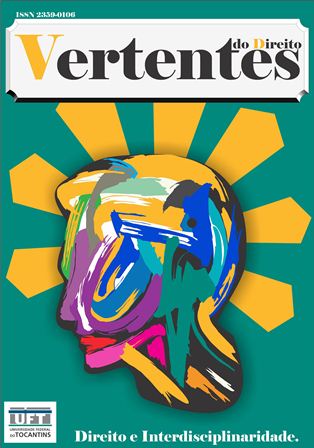A CRIMINALIZAÇÃO DO ABORTAMENTO VOLUNTÁRIO E SUAS CONSEQUÊNCIAS PARA A SAÚDE PÚBLICA: UMA ANÁLISE COMPARATISTA COM O ORDENAMENTO JURÍDICO BRITÂNICO E SOB A ÓTICA DO DIREITO CONSTITUCIONAL
DOI:
https://doi.org/10.20873/uft.2359-0106.2024.v11n1.p183-214Keywords:
Aborto, Antropologia, Democracia constitucional, Saúde Pública, Sopesamento de direitosAbstract
The objective of the present study was to analyze the balance of rights in the abortion theme under the paradigm of constitutional democracy, emphasizing how the right to information and non-disinformation, treated by Luigi Ferrajoli, are essential mechanisms for the maintenance of the democratic system. It was sought to illustrate, through Anthropology, how abortive techniques emerged and how they are still used in complex societies, that is, the similarity of events between different societies and historical moments was highlighted in order to erect what are the duties of the State before the act of illegal abortion. The study ends with a reflection on how the balancing of the rights of the unborn and the woman can occur in the subject of voluntary abortion, based on the implementation of the gradualist proposal by the British legal system. The procedural method used was both historical and observational, with regard to the anthropological approach, since, in order to achieve the proposed objective, it was necessary to investigate past events and institutions in order to verify their influences in today's society.
KEYWORDS: Abortion; Public Health; Antropology; England; Constitutional democracy; Balancing rights
References
BENIGNO, Gabriel Oliveira Loiola; VIEIRA, Diego Mota; OLIVEIRA, Jessica Eloísa de. Desigualdade de gênero nos Estados brasileiros e análise dos stakeholders do Conselho Nacional dos Direitos da Mulher. Rio de Janeiro: Revista de Administração Pública, 2021.
BOLTANSKI, Luc. As dimensões antropológicas do aborto. Brasília: Revista Brasileira de Ciência Política, 2012.
BOLTANSKI, Luc. La condizione fetale: una sociologia della generazione e dell’aborto. Itália: Feltrinelli, 2007.
BRITISH MEDICAL ASSOCIATION. Decriminalisation of abortion: a discussion paper from the BMA. Londres: [s.n.], 2017.
BRITISH MEDICAL ASSOCIATION. The law and ethics of abortion. Londres: [s.n.], 2020.
BRITISH MEDICAL ASSOCIATION. Domestic Abuse. Londres: [s.n.], 2014.
BRASIL. Artigo 226 da Constituição Federal de 1988. Trata do planejamento familiar. Disponível em: http://www.planalto.gov.br/ccivil_03/constituicao/constituicao.htm. Acesso em: 21 out. 2021.
CARDOSO, Bruno Baptista; VIEIRA, Fernanda Morena dos Santos; SARACENI, Valeria. Aborto no Brasil: o que dizem os dados oficiais? 21 fev. 2020. Disponível em: https://www.scielo.br/j/csp/a/8vBCLC5xDY9yhTx5qHk5RrL/?format=pdf&lang=pt. Acesso em: 19 set. 2021.
DEVEREUX, George. A study of abortion in primitive societies: a typological, distributional, and dynamic analysis of the prevention of birth in 400 preindustrial societies. 2. ed. rev. Nova Iorque: International Universities Press, 1976.
DINIZ et al. Aborto provocado e violência doméstica entre mulheres atendidas em uma maternidade pública de Salvador-BA. Brasília: Revista Brasileira de Enfermagem, 2011.
FERRAJOLI, Luigi. Poderes Selvagens: a crise da democracia italiana. São Paulo: Saraiva, 2014.
FERREIRA FILHO, Paulo Sérgio; MÜLLER, Felipe da Silva; RIBEIRO, Diaulas Costa. Aborto: uma abordagem econômica. ago. 2017. [S.l.]: Revista de estudos e pesquisas avançadas do terceiro setor. v. 4.
HARDY, Ellen; ALVES, Graciana. Complicações pós-aborto provocado: fatores associados. Rio de Janeiro: Cad. Saúde Pública, 1992.
MORIN, Edgar. Introdução ao Pensamento Complexo. Lisboa: Instituto Piaget, 2008.
NISHIDA, Erika. Quais números mudam após a legalização do aborto? 22 fev. 2021. Disponível em: https://gizmodo.uol.com.br/quais-numeros-mudam-legalizacao-aborto/. Acesso em: 23 out. 2021.
PAES, Bárbara. Acesso à informação e direitos das mulheres. São Paulo: Artigo 19, 2016.
SEGADO, Francisco Fernández (coord.). Dignidad de la persona, derechos fundamentales, justicia constitucional y otros estúdios de Derecho Público. Madri: Dykinson, 2008.
SOUZA MARIA et al. Plantas medicinais abortivas utilizadas por mulheres de UBS: etnofarmacologia e análises cromatográficas por CCD e CLAE. 2013. Disponível em: https://www.scielo.br/j/rbpm/a/HpKr6kbcY3zQKzcXnkW6MyQ/?format=pdf&lang=pt. Acesso em: 24 out. 2021.
SHELDON, Sally. The decriminalisation of abortion: an argument for modernisation. Inglaterra: Oxford Journal of Legal Studies, 2015.
SHELDON, Sally; WELLINGS Kaye. Decriminalising abortion in the UK: what would it mean? Grã-Bretanha: University of Bristol, 2020.
SHELDON et al. The Abortion Act (1967): a biography. Grã-Bretanha: Legal Studies, 2018.
UK PUBLIC GENERAL ACTS. Abortion Act 1967. Disponível em: https://www.legislation.gov.uk/ukpga/1967/87/section/1. Acesso em: 28 fev. 2022.
UK PUBLIC GENERAL ACTS. Offences against the Person Act 1861. Disponível em: https://www.legislation.gov.uk/ukpga/Vict/24-25/100/section/59. Acesso em: 28 fev. 2022.
UNITED NATIONS HUMAN RIGHTS. Declaration on the rights of persons belonging to national or ethnic, religious and linguistic minorities. [s.d.]. Disponível em: https://www.ohchr.org/en/professionalinterest/pages/minorities.aspx. Acesso em: 1 set. 2021.
UNITED NATIONS HUMAN RIGHTS. Minorities under international law. [s.d.]. Disponível em: https://www.ohchr.org/en/issues/minorities/pages/internationallaw.aspx. Acesso em: 1 set. 2021.
Downloads
Published
How to Cite
Issue
Section
License
Copyright (c) 2024 Jaqueline Valeri Soares, Robinson Henriques Alves

This work is licensed under a Creative Commons Attribution-NonCommercial 4.0 International License.
Os trabalhos aprovados para publicação tornar-se-ão propriedade da Revista sem qualquer ônus para a mesma. A Equipe Editorial se reserva o direito de promover as adequações necessárias para publicação.
O conteúdo dos trabalhos publicados na Revista Jurídica eletrônica Vertentes do Direito - inclusive quanto à sua veracidade, exatidão e atualização das informações e métodos de pesquisa - é de responsabilidade exclusiva dos autores. As opiniões e conclusões expressas não representam posições da Revista nem da Universidade Federal do Tocantins.
















